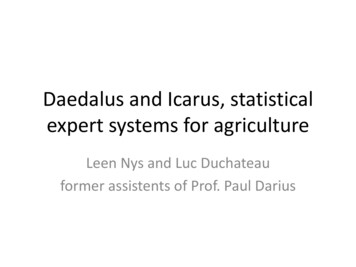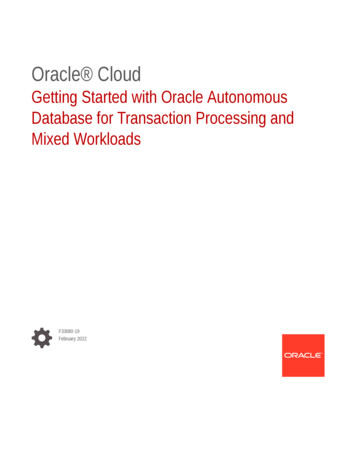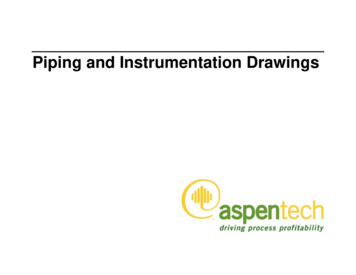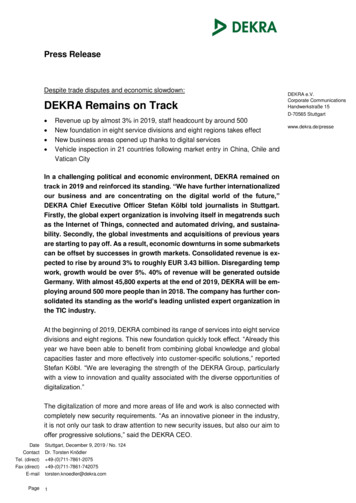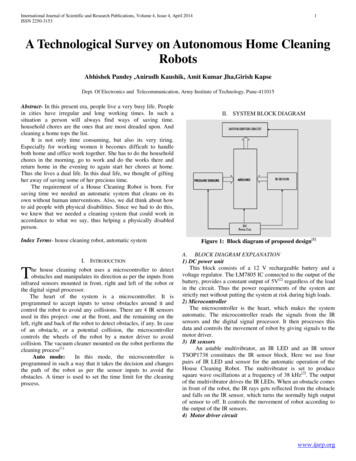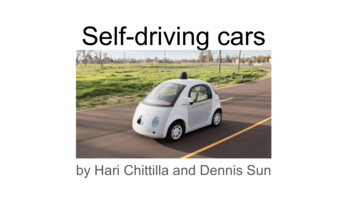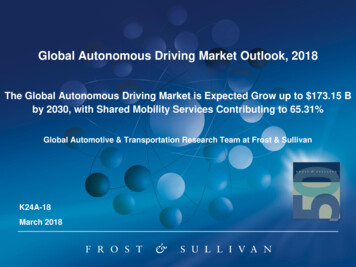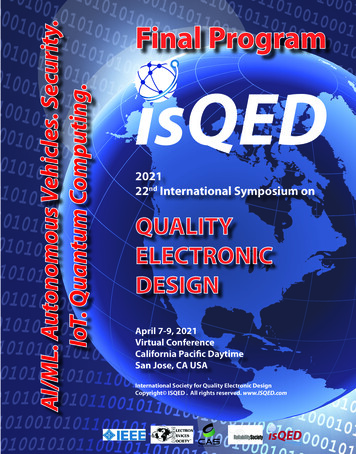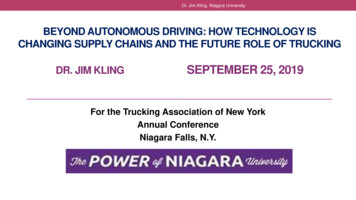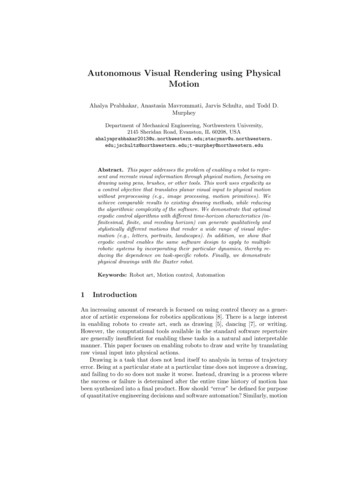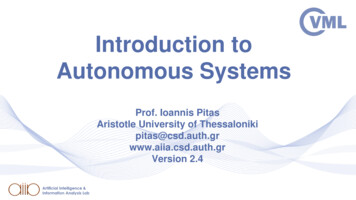
Transcription
Introduction toAutonomous SystemsProf. Ioannis PitasAristotle University of ersion 2.4
Autonomous Systems Definitions Applications Technologies Mission Planning Mission Control Perception Intelligence Embedded computing Autonomous systems swarms Communications
Autonomous SystemdefinitionsA fully autonomous system can: Gain information about the environment. Work for an extended period without human intervention. Move either all or part of itself throughout its operatingenvironment without human assistance. Avoid situations that are harmful to people, property, or itselfunless those are part of its design specifications.
Autonomous SystemdefinitionsSensorial signals (video, acoustic, tactile, radio signals) should beprocessed by an AS in real time to: interpret the external situation in which it operates; relate such a situation to its internal state, by observing it withother proprioceptive sensors, so that it becomes self-aware; to use representations to help its own control blocks to drive itsactuators; to be able to explain at sub-symbolic and symbolic level thereasons of its own choices.
Autonomous SystemdefinitionsAutonomous carstructureCourtecy L. Marcenaro, C. Regazzoni
Autonomous Systems Definitions Applications Cars Drones Marine systems Robots Technologies
Autonomous systemapplications Autonomous cars
Autonomous systemapplications Autonomous car sensors and perception
Autonomous teryFPV cameraFrameFlight control unit On-board computersAltimeterLIDARGimbalAV Camera99
Autonomous system applicationsDrone swarms
Autonomous system applicationsUndewater vehicles
Autonomous system applicationsMerchant ships
Autonomous system applicationsRobots
Autonomous Systemtechnologies Autonomous car structure
Autonomous Systemtechnologies Mission Planning and Control Perception and Intelligence Embedded computing Swarm systems Communications Societal technologies
Autonomous system mission Autonomous car mission List of navigation actions Motion along a 2D trajectory (path) Autonomous drone AV Shooting Mission: list of actions Shooting Actions: drone camerae.g., Lateral Tracking, Fly-Over, Orbit, Navigation Actions: drone action only, does not involve shootinge.g., Take-off, Land, Go-to-waypoint,
Autonomous system missionplanning Autonomous car mission planning Find the best (2D) trajectory from start to destination Planning constraints: Road map (e.g., Google maps) Regulatory restrictions (one way streets) Traffic load Use of semantic (2D) maps
Autonomous system missionplanning Google maps path planning.
Autonomous system missionplanning Drone mission planning. Planning of: Drone flight Payload (e.g., camera)actions Use of semantic 3D maps
Mission example: Giro d’Italia Accident Detected
Path Planner This submodule is used by: High-level Planner to estimate drone paths and flying times. Onboard Scheduler to compute a path to a landing position in case of emergency.Navigation map implemented as a grid. Obtained from Semantic Map. Semantic annotations are indicated as KML features. Geodesic coordinates translated into Cartesian. No-fly poligons become occupied cells in grid.Safe path computed using A* search algorithm. Fast for simple solution spaces.21
Path Planner Example Path from one corner to the other. Buildings labeled as no-fly zones (obstacles represented as redcrosses in the grid).Solved in 66 ms.22
Autonomous car control Car dynamic modellingInterfacing car perception to car controlLevels of car control automationLevelNameDriverDEM2DDTF30No automationHD4HDHD1Driver assistanceHD & systemHDHD2Partial automationSystemHDHD3Conditional automationSystemSystemHD4High automationSystemSystemSystem5Full automationSystemSystemSystem23
Autonomous car control
Autonomous car control Steering control Braking control Power control
Drone Mission Planning andControl Architecture
Drone Control Objectives –Trajectory TrackingTrack a trajectory.Realistic model.Robustness to disturbances.Bounded actuation.Large basin of attraction.2
Drone ControllerDrone Controller1TrajectoryGeneration231Drone Status2Target Status3Shooting Action parameters4Reference5Drone Velocity Command4TrajectoryTracking5
Onboard Drone control ArchitectureAutopilotSensors(IMU, GPS)OutputRTK GPSModel DynamicsOn-board Onboard utopilotExecutionCommsLTE / Wifi / RCShootingCameraAdditionalSensorsScheduling
Car collision avoidance Sensors for: Vehicle detection/localization Pedestrian detection Real-time car trajectory replanning forcollision avoidance.
Drone collision avoidance Collision hull defined as a cylinder (yellow). Horizontal conflict when reserved cylinder(green) overlaps with others. Vertical conflict when blocking cylinderoverlaps with others. Cylinders allow drones to brake on timeand maneuver to avoid collision.
Autonomous Systemtechnologies Mission Planning and Control Perception and Intelligence Embedded computing Swarm systems Communications Societal technologies
Autonomous car sensors Front/roof cameras
Autonomous car sensors Front/roof Lidars
3D localization sensors: GPS Other Satellite systems: GLONASS (Russia), BeiDou(China), Galileo (EU). RTK-GPS uses measurements of the phase of thesignal carrier wave, in addition to the informationcontent of the signal and relies on a singlereference ground station (or interpolated virtualstation) to provide real-time corrections, providingup to cm-level accuracy.
Drone Sensors: IMU Inertial Measurement Unit (IMU): It measures and reports a body's specific force,angular motion rate and, sometimes, themagnetic field surrounding the body. It uses a combination of meters.
Drone Sensors: Laser altimeter It measures the altitude (height) above a fixed ground level. It emits laser pulses which travel to the ground surface,where they are reflected. Part of the reflected radiation returns to the laser altimeter,is detected, and stops a time counter started when the pulsewas sent out. The distance is then easily calculated by taking the speedof light into consideration.
2D maps Google maps. OpenStreetMaps. Semantic annotated information: (roads, POIs, landing sites) in KML format inGoogle Maps. roads in OSM (XML) in case of OpenStreetMaps. Google Maps JavaScript API. OpenStreetMaps API.
3D maps Formats: 3D triangle mesh. 3D Octomap. Octomap : The octomap is a fully 3D model representing the 3D environment, where the UAVnavigates. It provides a volumetric representation of space, namely of the occupied, free andunknown areas. It is based on octrees and using probabilistic occupancy estimation.
Geometrical mappingLidar mappingRepeatibility40
Geometrical mappingValidation with a TOTAL STATION0 0.05 0.1 0.15 0.2 0.2541
Visual odometry𝐗𝑗𝐱1𝑗𝐏1𝐱3𝑗𝐱 2𝑗𝐏3𝐏2
3D Scene Reconstruction fromUncalibrated Multiple CamerasImages obtained from Google Earth3D models reconstructed in 3DF Zephyr Free using 50 images from Google Earth
Visual SLAMhttps://youtu.be/sr9H3ZsZCzc
Why is place recognitiondifficultLikely algorithm answer:NONOTRUE NEGATIVENO YES FALSE POSITIVE
Semantic 3D mappingCrowd detection
Semantic 3D Map annotation 2D Crowd region analysisand mapping
Semantic informationprojection on 3D maps
3D world modeling 3D road modeling Lane detection
Object detection Pedestrian, cars/vans/cyclist, road sign detection Current neural detectors are very capable of accurately detecting objects SSD, YOLO
Object detection But require domain-specific training or fine-tuning
Object detection Both can be trained when suitable annotations are available, e.g., YOLO for face and human detection, trained on WIDER dataset
Object detection acceleration Examples of acceleration techniques: Input size reduction. Specific object detection instead of multi-object detection. Parameter reduction. Post-training optimizations with TensorRT, including FP16 computations.
Object detectionacceleration YOLO: good precision in general, but too heavyweight small objects are more challenging to detect. Evaluation on VOC (Mean average precision, time):InputSizeFPSmAPForward time (ms)No TensorRTForward time (ms)TensorRTForward time 22.8
UAV Object detection & tracking
Object Tracking specs for carvision 2D visual tracking will be employed for target following.Satisfactory performance in road footage is required.Target tracking should be performed in real-time, i.e., 25 𝑓𝑝𝑠.Embedded implementation is required and low computational complexity ispreferred. Parallel or parallelizable methods (e.g., with CUDA implementations) shouldbe preferred as well. Assuming 2D target tracking methods operate faster than combining targetdetection and recognition methods, long-term object tracking is alsopreferred.
Joint Detection & Tracking Tracker: Given the initialized position of a target, the tracker 𝑇 is responsible for estimating thebounding box of the target in the subsequent frames. Detector/Verifier: Given a bounding box defining the target in a specific frame produced by the tracker,the detector 𝐷 is responsible for verifying this result, and then provide the appropriate feedback to thesystem. If the verification fails this module is responsible for detecting the target in a local search areaand provide the correct bounding box to the master node 𝑀 Master: 𝑀 is responsible for the coordination of the two aforementioned modules. The node providesthe necessary services to control the verification, the detection and the tracking tasks and controls thecommunication between the different parts of the system.
Joint Detection & Tracking Target re-initialization by the detector in hard tracking cases when trackingalgorithms fail
Joint Detection & Tracking Target re-initialization by the detector in hard tracking cases when tracking algorithms fail
Multi-Target Tracking The implementation is extended to support the tracking of multiple targets whilemaintaining real-time performance
3D/6D target localization 3D target localization using 3D mapsLidar localizationGPS target localizationTarget location and pose are desired
Target Pose Estimation Computer Vision Approach Relies on detecting a set of predefined points (e.g., facial landmarks) and thenusing a method for solving the respective Perspective-n-Point (PnP) problem,i.e., estimation of the camera position with respect to the object. Limitations: The 3-D coordinates for the landmark points must be known, i.e., a 3-D model ofthe object is needed The landmarks points must be precisely tracked, i.e., the texture of the objectmust allow for setting enough discriminative landmarks
Target Pose Estimation Machine Learning Approach A neural network receives the object and directly regresses its pose Only a set of pose-annotated object pictures are needed There is no need to manually develop 3-D models The models are more robust to variations of the object for which we want toestimate its pose The pose estimation can run entirely on GPU and (possibly) incorporatedinto a unified detection pose estimation neural network Very few pre-trained models are available Models must be trained for the objects of interest (faces, bicycles, boats,etc.)
Target Pose Estimation Machine Learning Approach We integrated a pre-trained yaw estimation model of facial pose (DeepGaze library) intothe SSD-300 object detector (trained to detect human faces) Varying illumination conditions seem to affect the estimation.
Pedestrian pose estimation(Openpose)65
Pedestrian pose estimation66
Advanced autonomous carIntelligence Self-awarenessDriver status modelling/recognitionAffective computingAttentionHuman (e.g., pedestrian) intention prediction
Autonomous Systemtechnologies Mission Planning and Control Perception and Intelligence Embedded computing Swarm systems Communications Societal technologies
GPU and multicore CPUarchitectures. Algorithm mapping NVIDIA embedded processing boards NVIDIA Jetson TX2 NVIDIA Jetson Xavier GPU and multicore CPU architectures»Multicore CPUs– GPUs Algorithm mapping:Convolutions
GPU and multicore CPUarchitectures. Algorithm mapping NVIDIA embedded processing boards NVIDIA Jetson TX2 NVIDIA Jetson Xavier GPU and multicore CPU architectures Multicore CPUsGPUs Algorithm mapping:Convolutions
Processing Units Multicore (CPU):MIMD.Focused on latency.Best single thread performance. Manycore (GPU):SIMD.Focused on throughput.Best for embarrassingly parallel tasks.
ARM Cortex-A57: High-End ARMv8CPU ARMv8 architecture Architecture evolution that extends ARM’s applicability to all markets.–Full ARM 32-bit compatibility, streamlined 64-bit capability. High-performance next-generation microarchitecture– Improved performance on all workloads – 32b/64b integer, FP / SIMD.– Optimized for modern high-end workloads.– Significant improvements in power efficiency.
GPU and multicore CPU architectures.Algorithm mapping NVIDIA embedded processing boards NVIDIA Jetson TX2 NVIDIA Jetson Xavier GPU and multicore CPU architectures Multicore CPUsGPUs Algorithm mapping:Convolutions
GPU Optimization Spawn threads.Use registers.Loop unrolling.Use SIMD capabilities.Take data locality into consideration.Trust the compiler.
Pascal e-pascal/gp100 block diagram-2/
Pascal e-pascal/gp100 sm diagram/
GeForce GTX 1080 Microarchitecture: Pascal. DRAM: 8 GB GDDR5X at 10000 MHz. SMs: 20. Memory bandwidth: 320 GB/s. CUDA cores: 2560. L2 Cache: 2048 KB. Clock (base/boost): 1607/1733 MHz. L1 Cache: 48 KB per SM. GFLOPs: 8873. Shared memory: 96 KB per SM.
NVIDIA Jetson Xavier AI Computer for autonomous machines Designed for robots, drones and other Multiple operating modes (10/15/30 W) Comparison to TX2:Greater than 10x the energy efficiency.More than 20x the performance
CUDA Compute Unified Device Architecture (CUDA) is aparallel programming framework. Developed by Nvidia. Started as an attempt to give C/C programsaccess to GPU resources. Microarchitectures are name after famousphysicists (Kepler, Maxwell, Pascal, Turing, Volta).
CUDA Data in CPU RAM are moved to device RAM, then deviceL2 cache then SM L1 cache. The CUDA kernel is the function that will run in parallel. When a kernel is launched, threads are grouped intoblocks and all blocks form the CUDA grid for the kernel. Blocks are assigned to SMs in thread warps. Each CUDA kernel can handle 4 threads. GPU usage can be monitored through command line tools(nvidia-smi) or NVIDIA’s API (NVAPI).
GPU and multicore CPU architectures.Algorithm mapping NVIDIA embedded processing boards NVIDIA Jetson TX2 NVIDIA Jetson Xavier GPU and multicore CPU architectures Multicore CPUs GPUs Algorithm mapping:Convolutions
Introduction to fast CNNconvolution algorithms Typical 2D convolutional layer 𝑙 of a CNN:input feature map 𝐗 𝑙 : 𝑁𝑙 𝑀𝑙 𝐶𝑙 -dimensional 3D tensor 𝐰𝑙,𝑘 : 𝑁𝑙,𝑘 𝑊𝑙,𝑘 𝐶𝑙 -dimensional 3D tensor 𝑏 𝑙, 𝑘 : bias term 𝑓: nonlinear activation function
Fast 1D convolution algorithmswith minimal computationalcomplexity Winograd convolution algorithms Require only 2𝑁 𝑣 multiplicationsin their middle vector product, thushaving minimal multiplicative complexity
Autonomous Systemtechnologies Mission Planning and Control Perception and Intelligence Embedded computing Swarm systems Communications Societal technologies
Autonomous Systems swarms Car platoon control
Autonomous Systems swarms Lane-less highways Collision avoidance Fluid dynamicsprinciples
Drone swarms
Leader-following for droneformation control Main idea:Trailer-like behavior for the followers.In inertial frame:Translated identical pathsIn trailer frame:Different paths, no superposition89
SA1 - Constant relative positions
Autonomous Systemtechnologies Mission Planning and Control Perception and Intelligence Embedded computing Swarm systems Communications Societal technologies
Autonomous SystemCommunications Communication infrastructure Video streaming
Autonomous Systemcommunications Communication infrastructure Vehicle2ground Vehicle2vehicle 5G/LTE/WiFi communications Ground2vehicle command communications Sensor data, telemetry communications Communication latency QoS in communications Robustness, security
Drone Swarm Communicationinfrastructure Drone2DroneCommunication. Drone2Groundcommunication. Live broadcasting.
Drone CommunicationsInfrastructureObjective: Secured and resilient transparent IP access to drones /ground station (LTE and WiFi).Private network (no connection with external wide network)Drone 1Ground StationSubnet 2 (LTE)INTERNAL(10.10.40.0/24)Drone 3Subnet 4.1(Drone coms board #1)192.168.1.0/24Subnet 3 (Wifi mesh)INTERNAL(11.11.0.0/24)Drone 2Subnet 1 & 1bis(Ground network)172.16.10.0/24172.16.11.0/24Subnet 4.3(Drone coms board #3)192.168.3.0/24Subnet 4.2(Drone coms board #2)192.168.2.0/24
Drone CommunicationsInfrastructure LTE & Wi-Fi communications Default IP gateway to the ground and to other drones. Route traffic to/from wireless link interfaces (LTE & Wi-Fi) Transparent to the users of the com. module. QoS : mark and Schedule IP flows depending on applications QoS priority recognized thanks to: IP-mark in DSCP field or Planned IP 5-tuple (@src, @dest, Psrc, Pdest, proto).
Drone CommunicationsInfrastructure LTE & Wi-Fi communications Admission control. Traffic shaping (when congestion occurs). Communications authentication, encryption and other securityrelated mechanisms. Monitor and report communication link availability.
5G Communications Infrastructure Internet of Vehicles Massive deployment, throughput Ultra low latency networks Robustness Edge/cloud computing
Autonomous SystemCommunications Communication infrastructure Video streaming
Drone Digital Video StreamingProblem 1: NetworkConsiderations:Wireless communication with receiver - weak & subject to failure (distance,obstacles, other wireless networks etc).Good quality video is massive in terms of Mbps required to transfer it1 second of 720p (1280x720) 8-bit video requires 65.92MBytes – prohibitive.Video compression must be used prior to streaming:H264 & H265 coding are great candidates. but they inevitably introduce delays (compression decompression)Lossy: must find trade-off between latency & quality.Which network protocol should be used?Real-time Transport Protocol (RTP) with User Datagram Protocol (UDP)TCP is also standardized for use with RTP, but favors reliability instead oftimeliness.
Drone Digital Video StreamingProblem 1: NetworkCompression takes place on-board the droneNVIDIA’s Jetson TX2 module offers.hardware accelerated image/videocompression.Also a 256-core Pascal @ 1300MHz GPUwith capability comparable to anIntel Xeon E5-2960 v4 CPU in DeepLearning tasks.
Drone Digital Video StreamingProblem 1: NetworkRTP Packetstimestamp: 32 bitsThe timestamp reflects the sampling instant of the first octetin the RTP data packet.The initial value of the timestamp is random, as for the sequencenumber. Several consecutive RTP packets may have equal timestamps ifthey are (logically) generated at once, e.g., belong to the samevideo frame.
Drone Digital Video StreamingProblem 1: NetworkHow to synchronize all streams?RTP Control Protocol (RTCP) may be used in conjunction with RTPMore on RTP/RTCP: https://tools.ietf.org/html/rfc1889NTP timestamp: 64 bitsIndicates the wallclock time when this report was sent so thatit may be used in combination with timestamps returned inreception reports from other receivers to measure round-trippropagation to those receivers.
Drone Digital Video StreamingProblem 2: Synchronization From wikipedia:Network Time Protocol (NTP) is a networking protocol for clocksynchronization between computer systems over packet-switched, variablelatency data networks. NTP is used to synchronize the clocks of all servers & clients. This ensures all participating devices use the same clock.
Drone Digital Video StreamingProblem 2: SynchronizationScenario 2: multiple drones - one ground station.
Drone Digital Video StreamingProblem 2: SynchronizationAlongside the stream, visual analysis of the video frames must take place.More delays - more synchronization problems.Metadata needs to accompany each video frame, such as:NTP timestamp corresponding to the moment of the frame’s captureDrone telemetry statusGimbal statusCamera status.Metadata can be sent as a separate stream, but synchronization ofmetadata & video frames must take place at the receiver – problematic.They may be inserted into the stream, but they must survive thecompression (no watermarking).Better yet (probably): insert metadata as RTP header extension.
Solutions & Tools: GstreamerGstreamer is written in C, but offers bindings in multiple gs/Recommended: original C or C or Python.Sample streamer receiver are provided in Python:They show how to access pipeline elements & modify them, interceptbuffers etchttps://lazka.github.io/pgi-docs/#Gst-1.0 python bindingsGstreamer official cumentation/Useful elements for custom streams: appsrc and appsink.
Solutions & Tools: GStreamer ExamplesGStreamer: open source multimedia framework“pluggable components [that] can be mixed and matched into arbitrarypipelines”Example using gst-launch (command line pipeline parser):gst-launch-1.0 v4l2src ! autovideosinkOpens a usb camera (if one is plugged in) & displays the image in a windowgst-launch-1.0 v4l2src device /dev/video0 ! video/x-raw,width 640,height 480 ! autovideosinkCaps: set various properties of the stream according to the device’s capabilities
Solutions & Tools: Gstreamer examplesH264 compression RTP streaming:gst-launch-1.0 v4l2src ! x264enc ! video/x-h264, stream-format byte-stream ! h264parse ! rtph264pay config-interval 1 ! udpsinkport 5000Receive display:gst-launch-1.0 udpsrc port 5000 caps "application/x-rtp,media (string)video,clock-rate (int)90000,encoding-name (string)H264" !rtph264depay ! avdec h264 ! autovideosinkgst-launch is great for understanding gstreamer concepts but for more complex matters, code must be written
Solutions & Tools: GStreamer examplesRptBin element: RTP/RTCP functionalitySender:gst-launch-1.0 rtpbin name rtpbin ntp-time-source ntp rtcp-sync-send-time false v4l2src device /dev/video0 do-timestamp true ! timeoverlay !x264enc bitrate 3000000 ! video/x-h264, stream-format byte-stream ! h264parse ! rtph264pay config-interval 1 ! rtpbin.send rtp sink 0rtpbin.send rtp src 0 ! udpsink port 5000 rtpbin.send rtcp src 0 ! udpsink port 5001 sync false async false udpsrc port 5005 !rtpbin.recv rtcp sink 0Receiver:gst-launch-1.0 -v rtpbin name rtpbin ntp-sync true ntp-time-source ntp buffer-mode synced udpsrc caps "application/xrtp,media (string)video,clock-rate (int)90000,encoding-name (string)H264" port 5000 ! rtpbin.recv rtp sink 0 rtpbin. ! rtph264depay ! avdec h264 !autovideosink udpsrc port 5001 ! rtpbin.recv rtcp sink 0 rtpbin.send rtcp src 0 ! udpsink port 5005 sync false async d-plugins-rtpbin.html
Autonomous Systemtechnologies Mission Planning and Control Perception and Intelligence Embedded computing Swarm systems Communications Societal technologies: Security Safety Privacy protection
Safety, Security andethics Misuse avoidanceno specific legislation prescribes protective measures against misuse andvulnerability exploitation.Vehicle hacking, GPS signal jamming, weak security in communicationscan also allow obtaining the video captured by the drone, or its intendedflight path.Redundant active perception methods (vehicle localization), secure andsigned autopilot firmware updates, as well as autopilot input commandsfiltering, can be employed to this end. Data securityFootage data collected by vehicles raise privacy concerns.112
Data securityrequirements The types of data that must be protected are: data stored within vehicles: On-vehicle data encryption, allowing access to authenticated peopleonly. data stored in ground infrastructure. data transmitted over the air: Wifi and radio data transmitted should be encrypted. Data protection can be achieved with ciphering and authenticationmechanisms, e.g. IPSec over LTE for transmitted data. data that are to be publicly distributed (e.g., AV datasets)113
Privacy and dataprotection Protection of personal data must be ensured in the acquired videoand/or images. The EU’s General Data Protection Regulation 2016/679), repealingthe 1995 Data Protection Directive. “Member States shall protect the fundamental rights and freedoms ofnatural persons and in particular their right to privacy, with respect tothe processing and distribution of personal data.”114
Data protection issues incars Location/trajectory data Car sensor data Driver performance data Data communication security/privacy issuesVehicle2vehicle communicationsVehicle to road/ground infrastructure communications115
Data protection issues indrones Public perceives drones as machines infringing privacy.No flights above private property.Distinguish between: actors, spectators, crowd public events, private events.Data protection issues for AV shooting: for broadcasting for creating experimental data bases. Use of data de-identification algorithms when doing AVshooting.116
Privacy Protection An issue of ethics and security Post-production stage Approaches Face de-detection (Face detector obfuscation) Naïve approach SVD-DID Face de-identification (face recognizer obfuscation) Gaussian blur Hypersphere projection
Privacy Protection: acceptablefacial image quality?Original ImageGaussian blur withstd. deviation of 5Hypersphereprojection withradius of 8
Application on dronevideos120
Face recognition/deidentification/privacy protection
UAV flight regulations inEU UAVs 2kg are allowed within a 50m flight radius withoutprofessional pilot license. Pilot license and drone insurance are required for all professionalapplications. UAVs 2kg of weight may be required to carry emergencyparachutes (France). UAVs exceeding 15kg of weight might require special license oreven be prohibited (Germany).122
UAV flight regulations inEU Maximum flight altitude is typically restricted to 120m or 150m (400ft or 500ft)within several European countries. Line of sight must be maintained by the licensed pilot of the UAV at all times,either physically, or using visual aids (e.g., VR-goggles). Horizontal distance between the drone and the pilot is typically limited tospecific meters (e.g., 500m). Outdoor UAV flight is restricted/prohibited above congested areas, crowds ofpeople and airports, leading to permissible flight zones delineated by law. Inherently complying with such a complex and varying web of regulations (geofencing) is a challenge for all autonomous UAV applications (e.g., DJI appautomatically downloads and determines permitted flight zones).123
Other UAV safety issues Potential Landing Site Detection Crowd detection and avoidance124
Mission simulations Simulations in Gazebo Simulations in Unreal Engine and AirSim Simulations for training data generation125
Pilot Study - Test ContentObject ModelsBackground Environment126
Test Sequence Example II: S2VIDEO: Scenario 2 with drone height of 1, 2, 6, 10 and 14m.127
Bibliography[REG2019] C. Regazzoni, I.Pitas, “Perspectives in Autonomous Systems Research”,Signal Processing Magazine, vol. 36, no. 5, pp. 147-148, 2019[SIE2011] R. Siegwart et al, “Introduction To Autonomous Mobile Robots ”, MIT Press,2011.[MAD 2019a] I. Mademlis, A. Torres-Gonzalez, J. Capitan, R. Cunha, B. Guerreiro, A.Messina, F. Negro, C. Le Barz, T. Goncalves, A.Tefas, N.Nikolaidis and I.Pitas, “AMultiple-UAV Software Architecture for Autonomous Media Production”, Proceedingsof the 27th European Signal Processing Conference (EUSIPCO), Satellite Workshop:Signal Processing, Computer Vision and Deep Learning for Autonomous Systems, ACoruna, Spain, 2019[MAD2019b] I. Mademlis, P. Nousi, C. Le Barz, T. Goncalves and I.Pitas,“Communications for Autonomous Unmanned Aerial Vehicle Fleets in OutdoorCinematography Applications”, Proceedings of the 27th European Signal ProcessingConference (EUSIPCO), Satellite Workshop: Signal Processing, Computer Vision andDeep Learning for Autonomous Systems, A Coruna, Spain, 201962
Q&AThank you very much for your attention!Contact: Prof. I. Pitaspitas@csd.auth.gr129
Introduction to Autonomous Systems Prof. Ioannis Pitas Aristotle University of Thessaloniki . Mission Control Perception Intelligence Embedded computing Autonomous systems swarms Communications. Autonomous System definitions A fully autono
